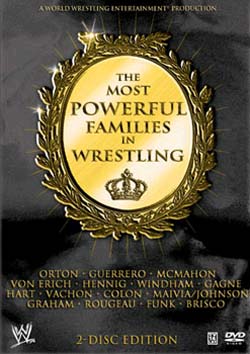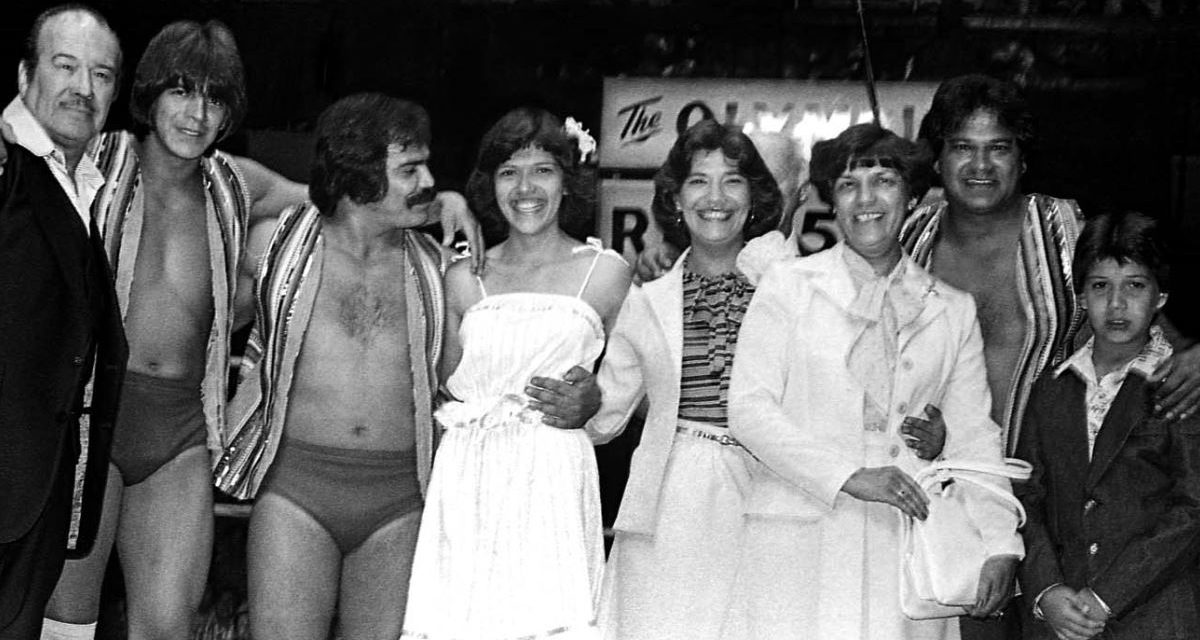When a wrestling historian hears about a new DVD from WWE that documents wrestling’s past, he or she will tend to approach with caution.
Perhaps their fear is appropriate. After all, WWE does have a bit of a checkered past when it comes to recognizing what has truly happened in the industry’s past (WrestleMania 3’s attendance is but one shining example of this).
Over the last few releases, such as the recent Four Horsemen documentary, WWE has showed itself to be more friendly towards keeping its reporting on wrestling’s past reasonably accurate.

That mood will surely continue with the recent release, Wrestling’s Most Powerful Families, which is a mini-doc compilation look at, as implied, the bloodlines of the demi-sport.
The big question that some historians may have going in is the thoroughness of the WWE history department. While the lineage of, say, the McMahon family, will be complete, others may fear that influential families are not well documented.
To those who hold such concerns, little that I or any other wrestling journalist will say can do little to persuade you to change your opinion. If you are, for example, expecting to learn about the history of the Jarrett family, don’t look to a WWE DVD for answers. After all, there’s no reason for the Fed to promote anyone outside of their own organization.
That being said, the work done is pretty damn thorough. Particularly impressive to me was the profile of the Orton family. Bob Sr., Bob Jr., Randy and even Barry are given some time in the spotlight, in part due to archived footage from WWE TV or other documentaries. Heck, even wrestlers who either never or barely worked for any of the Fed’s incarnations, such as Carlos Colon, are thoroughly reviewed.
If there is one commonality that can be found through many of the families who receive full documentation, it is that they were the heads of several of the territories back in the day. This includes the aforementioned Colons, the Gagnes, the Von Erichs (described in their kayfabe name), the Rougeaus and the Harts.
It is the latter of these groups that is perhaps the most interesting. The Hart family story, which is so tightly interwoven in WWE’s ’80s and ’90s history, is very well documented here, with Stu, Bret, Owen and the other brothers receiving attention, as well as Davey Boy Smith and Jim Neidhart. WWE even goes a step further, talking about Nattie Neidhart and Harry Smith (though the latter’s WWE “debut” is not shown) and hinting at them being the “next” Hart Foundation.
That’s not to say, though, that non-bosses are not included in the list. One segment on the DVD is dedicated to some of the “other” families, such as the Malenkos and the Hennigs. Obviously, these lineages could have been included, but you certainly cannot blame WWE Home Video for drawing the always hard line in the sand.
If you were to ask me, though, about my favourite segment on the DVD, it is the Mythbusters section. Here, WWE blows kayfabe out of the water. While some of the “families”, such as the Hollys are most certainly not surprises, the Anderson family tree is burned to the ground, and let’s face it — which of us, as kids, really didn’t think that Arn and Ole were truly blood relatives? They sure looked alike.
Most entertaining here is the revelation about the Dudley family tree, which is not only torched, but absolutely incinerated. Methinks Big Daddy Dudley is rolling over in his grave.
Not surprisingly though, WWE conveniently only dissuades the myths that are now defunct in WWE storyline. For example, Edge and Christian’s kinship is destroyed, but The Undertaker and Kane’s bloodline remains intact.
So are there any inexplicable holes in the WWE DVD? Naturally. Though not in the same genre of “power” as the Harts, the Hardy brothers, Matt and Jeff, are arguably one of the most successful sibling combinations in recent WWE history, both in terms of fan popularity and revenue generated either in gate or merchandise sales.
In a somewhat similar respect, I was a bit surprised that the Laurinitises (better known as Johnny Ace and Animal) were not included, nor were WWE’s favourite DVD sons, Bruce and Tom Pritchard. My feeling is that the recent departures in the Fed had as much to do with the exclusion of these bloodlines as much as anything else.
If, however, there are two booboos that cannot be justified, it is the exclusion of the Steiners and the Poffos. In the former’s case, the TNA factor that kept the Jarretts off the recording probably applied, but the legacy of Rick and Scott built should not have been ignored. In the latter’s case, there is no central reason for the father and sons to not be included. Unless someone in power still holds a grudge against one of them.
Other prominent missing families may not mean as much to today’s fan — the Welches/Fullers, the Baillargeons, the Christys, the Duseks, the Zahariases — but meant a lot to the establishment of professional wrestling over the years.
I will applaud WWE, however, for not doing too much on the “failed families” such as the Flairs. Consider this to be the Gretzky effect. While Wayne is one of the greatest the NHL has ever seen, his brothers, Brent and Keith, had largely forgettable careers. Same here, as Ric is one of the best to ever step foot in the ring, but his son David certainly did not live up to the family lineage before leaving the industry.
The Flairs, however, are in a different section that focuses on how hard it is for a son to live up to his father’s legacy. The same goes for the Rhodes (Dusty and Dustin, no mention of Cody mind you), the Sammartinos (Bruno and David) and others. This segment is offset by sons who superseded their fathers’ shadows, such as the Dibiases.
Overall, Wrestling’s Most Powerful Families is a great watch and I cannot recommend it enough to the new fan. Though the historian may disagree with the scope of the recording, you cannot deny that it’s an interesting look at pro wrestling’s lineage.

